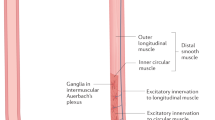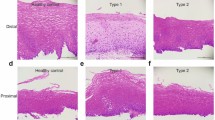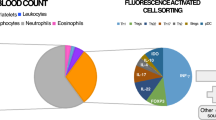Abstract
Idiopathic achalasia is a severe motility disorder of the esophagus and is characterized by a failure of the lower esophageal sphincter to relax due to a loss of neurons in the myenteric plexus. Most recently, we identified an eight-amino-acid insertion in the cytoplasmic tail of HLA-DQβ1 as strong achalasia risk factor in a sample set from Central Europe, Italy and Spain. Here, we tested whether the HLA-DQβ1 insertion also confers achalasia risk in the Polish and Swedish population. We could replicate the initial findings and the insertion shows strong achalasia association in both samples (Poland P=1.84 × 10−04, Sweden P=7.44 × 10−05). Combining all five European data sets – Central Europe, Italy, Spain, Poland and Sweden – the insertion is achalasia associated with Pcombined=1.67 × 10−35. In addition, we observe that the frequency of the insertion shows a geospatial north–south gradient. The insertion is less common in northern (around 6–7% in patients and 2% in controls from Sweden and Poland) compared with southern Europeans (~16% in patients and 8% in controls from Italy) and shows a stronger attributable risk in the southern European population. Our study provides evidence that the prevalence of achalasia may differ between populations.
Similar content being viewed by others
Log in or create a free account to read this content
Gain free access to this article, as well as selected content from this journal and more on nature.com
or
References
Gockel HR, Schumacher J, Gockel I, Lang H, Haaf T, Nothen MM : Achalasia: will genetic studies provide insights? Hum Genet 2010; 128: 353–364.
Gockel I, Becker J, Wouters MM et al: Common variants in the HLA-DQ region confer susceptibility to idiopathic achalasia. Nat Genet 2014; 46: 901–904.
Einarsdottir K, Humphreys K, Bonnard C et al: Linkage disequilibrium mapping of CHEK2: common variation and breast cancer risk. PLoS Med 2006; 3: e168.
Jia X, Han B, Onengut-Gumuscu S et al: Imputing amino acid polymorphisms in human leukocyte antigens. PLoS One 2013; 8: e64683.
Schaid DJ, Sommer SS : Genotype relative risks: methods for design and analysis of candidate-gene association studies. Am J Hum Genet 1993; 53: 1114–1126.
Borchers AT, Uibo R, Gershwin ME : The geoepidemiology of type 1 diabetes. Autoimmun Rev 2010; 9: A355–365.
Kiryluk K, Li Y, Sanna-Cherchi S et al: Geographic differences in genetic susceptibility to IgA nephropathy: GWAS replication study and geospatial risk analysis. PLoS Genet 2012; 8: e1002765.
Ho KY, Tay HH, Kang JY : A prospective study of the clinical features, manometric findings, incidence and prevalence of achalasia in Singapore. J Gastroenterol Hepatol 1999; 14: 791–795.
Farrukh A, DeCaestecker J, Mayberry JF : An epidemiological study of achalasia among the South Asian population of Leicester, 1986-2005. Dysphagia 2008; 23: 161–164.
Kwon HY, Lim JH, Shin YW, Kim CW : A case of chronic cough caused by achalasia misconceived as gastroesophageal reflux disease. Allergy Asthma Immunol Res 2014; 6: 573–576.
Acknowledgements
We thank all patients for participating in this study. We acknowledge our collaborating clinical partners, all colleagues who contributed to the patient’s recruitment, our laboratory technicians and colleagues responsible for database management. We thank the Type I Diabetes Genetics Consortium (T1DGC) for data access. IG, MK and JS received support for this work from the Deutsche Forschungsgemeinschaft (DFG), individual grants GO 1795/1-1, KN 378/2-1 and SCHU 1596/5-1. MMN received support for this work from the Alfried Krupp von Bohlen und Halbach-Stiftung, and is a member of the DFG funded Excellence Cluster ImmunoSensation. PIWdB is the recipient of a Vernieuwingsimpuls VIDI Award from the Netherlands Organization for Scientific Research (NWO). MMW is supported by a postdoctoral fellowship of the Fund for Scientific Research (FWO) Flanders, Belgium. GEB is supported by a grant from the Research Foundation – Flanders (FWO, Odysseus program). AT is supported by grants from the Erling-Persson Family Foundation, Sweden. The Heinz Nixdorf Recall cohort was established with the generous support of the Heinz Nixdorf Foundation, Germany.
Author information
Authors and Affiliations
Corresponding author
Ethics declarations
Competing interests
The authors declare no conflict of interest.
Additional information
Supplementary Information accompanies this paper on European Journal of Human Genetics website
Supplementary information
Rights and permissions
About this article
Cite this article
Becker, J., Haas, S., Mokrowiecka, A. et al. The HLA-DQβ1 insertion is a strong achalasia risk factor and displays a geospatial north–south gradient among Europeans. Eur J Hum Genet 24, 1228–1231 (2016). https://doi.org/10.1038/ejhg.2015.262
Received:
Revised:
Accepted:
Published:
Issue date:
DOI: https://doi.org/10.1038/ejhg.2015.262
This article is cited by
-
Achalasia
Nature Reviews Disease Primers (2022)
-
Gelatinase B/Matrix Metalloproteinase-9 as Innate Immune Effector Molecule in Achalasia
Clinical and Translational Gastroenterology (2018)



